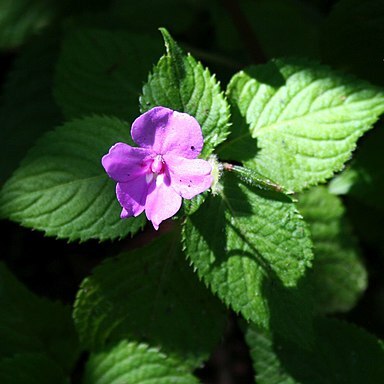Leaves spirally arranged, petiolate; lamina 2–7 × 1·8–4·5 cm., ovate to ovate-lanceolate, membranous, pilose on both surfaces (mainly on the nerves) or glabrescent or rarely quite glabrous, dark green on the upper surface, bright green or greyish-green on the lower one, apex acute or subobtuse, margin crenate or crenate-denticulate to serrate, base usually broadly cuneate, rarely ± rounded; secondary nerves 5–8 pairs, prominent beneath; petiole 0·8–3·2 cm. long, canaliculate, sometimes densely but usually sparsely pilose or often glabrous.
Lateral sepals 4–6·5 × 0·9–1·25 mm., lanceolate-triangular, acute, ± densely pilose, with longer hairs along the margins; posterior sepal 9–11 (13) mm. long, 3–4 mm. deep, shallowly and obliquely navicular, abruptly constricted into the spur, distally subcaudate, pilose (especially along the keel-line); spur 11–15 (18) mm. long (or even somewhat longer), rather slender, tapering into a bluntish point, rarely with the end slightly thickened, always ± incurved.
Flowers axillary, usually solitary, rarely in fascicles of 2 or 3 (but then usually only one developed at a time), pinkish-purple or pink with deep red blotches at the base of the lateral petals; bracts very small, lanceolate-triangular, acute, usually pilose; pedicels 1·5–3 (3·5) cm. long, very slender, usually pilose (sometimes densely so), rarely glabrous.
Low, scrambling or erect, annual or perennial herb, up to 300 mm tall. Leaves sparsely pubescent above and below, more densely so on younger leaves. Lateral united petals 8-14 mm long with distinct magenta spot towards base. Flowers pink.
Low scrambling or upright (perennial?) herb; stems succulent, pinkish or green, often rooting at the nodes, glabrous or sparsely pilose (mainly when young).
Seeds numerous, not seen in a mature state (c. 1·4 × 0·9 mm. ?), dark brown, glabrous (the surface smooth?).
Capsule up to 1·5 cm. long, fusiform, pilose or glabrescent.
Ovary ± densely pilose.

